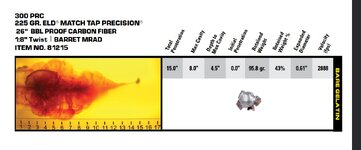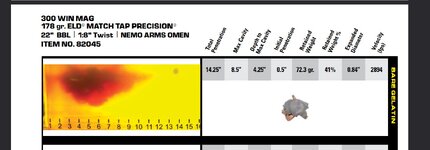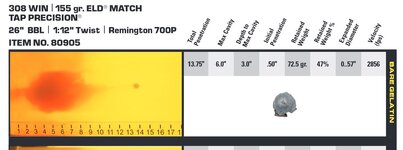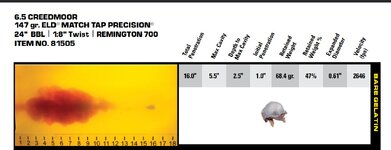Are there statistically significant sample sized experiments that compare the same bullet type to caliber with respect to terminal performance? (ie. 6mm 108 ELDM compared to a 6.5mm ELDM compared to a 7mm 180 ELDM) Controls would include impact velocity, terminal media consistency, and angle of entry, etc. The purpose would be to understand what is being gained or given up by bullet caliber.
It would be so incredible to have some real "statistically significant" data sets together to help to answer these questions with real information. But I haven't seen it. Granted, as other's have commented, it is difficult to document terminal ballistic performance on actual animals because of the large variance in environment, animal behaviour, and shooters' recall. But there are those who are working on it. Portland State University has an ongoing study which needs all of our data:
www.bit.ly/AmmoPerformance
I myself have started to compile a spreadsheet of the necropsy reports on this forum. I hope to complete that data entry project and publish the results sometime soon.
I hope that by gathering larger and larger sets of actual terminal ballistic field results trends will be identified.
I do give a lot of weight to those who have seen thousands of animals killed in the field. But the only two I know of who have shared their findings are Nathan Foster and Form. (Any others out there?) And although much of what they document and say is similar, (ie.. frangible/ soft bullets are a "must" at slower impact velocities and mono coppers wound less and need speed.) They do seemingly disagree on the value of larger caliber bullets on larger game.
Nathan's writings can be found here and I highly recommend his books:
Expert rifle & cartridge research, carefully compiled through extensive field-testing & freely offered to the firearms community.
www.ballisticstudies.com
The only thing that is close to actual scientific data that I've been able to find is the online ballistic data from Hornady's law enforcement site. It has lots of test data for different bullets.
Attached you will find screen shots of various ELD-M bullets which shows an interesting trend. There is a clear tendency for the larger and heavier ELD-M bullets to penetrate more deeply and expand to create larger wound cavities.
225 gr. ELD-M in .308 @2888fps; 15" penetration and 8" dia. Max. Cavity
178 gr ELD-M in .308 @2894 fps; 14.25" penetration and 8.25" Max. Cavity
155 gr. ELD-M in .308 @2856 fps; 13.75" penetration and 6.00" Max Cavity
147 gr. ELD-M in 6.5mm @2646; 16" penetration and 5.5" Max Cavity
(Note the 6.5 bullet was traveling 200 fps +/- slower at impact which explains the deeper penetration. But the three .308's all impacted at very similar velocities.)
It "feels" logical to me that when comparing the same bullet: more weight, more diameter and more speed will equal more wound cavity and that at the same impact velocity a heavier, bigger bullet will also penetrate more deeply. But many on this site swear that isn't the case and I have less field experience then them so I'm left confused and deeply unsatisfied with the lack of data around an issue that would be easily "provable" in a properly orchestrated study. I've heard Form say that a bullet could be designed in .308 caliber that would produce massive soccer ball sized wounding, but have also seen him write that there is no significant difference in wounding created by .223 vs. .308 bullets. (not exact quotes, sorry.)
Bottom line is that I feel that this should be "settled" with real data for every hunting bullet on the market so we could move on to arguing about some other crazy hunting nuance. (or god forbid, by going to the range and shooting more!)
Also, I think it would be preliminary to look at this Hornady data and claim that it offers clear proof that there is an advantage in wounding and penetration by larger caliber and heavier bullets. Hornady doesn't state how many test shots were fired and I'm left with a sneaky suspicion it might have just been one of each bullet. To do this right, I think you'd need to do a larger sample size of each. And it would be important to test each at various impact velocities. The velocity of impact for all of these tests is pretty high at 2580-2730 which doesn't tell us how this bullet performs at lower velocities which is absolutely key for choosing a hunting bullet.
Interestingly, the comparison of the various CX mono copper bullets in the same publication does not yield the same trend of heavier, larger bullets creating more wounding.... Food for thought.
Before someone else points this out, let me state that it is very clear when one dives deeply into this that what really matters by a VERY large margin is bullet placement. In the hundreds of necropsy entries I have entered data for so far it is clear that if you hit an animal in the heart/lung complex with a well placed shot you are very likely to recover it within 40 yards of impact. No matter the caliber or projectile.
However, for reasons that others have pointed out: 1) debunking the lies that we've been fed 2) striving to be more ethical hunters 3) desiring exiting for blood tracking in heavy cover 4) balancing meat loss vs. quick killing and more,,, I will argue that this subject has real value and merit to pursue.





